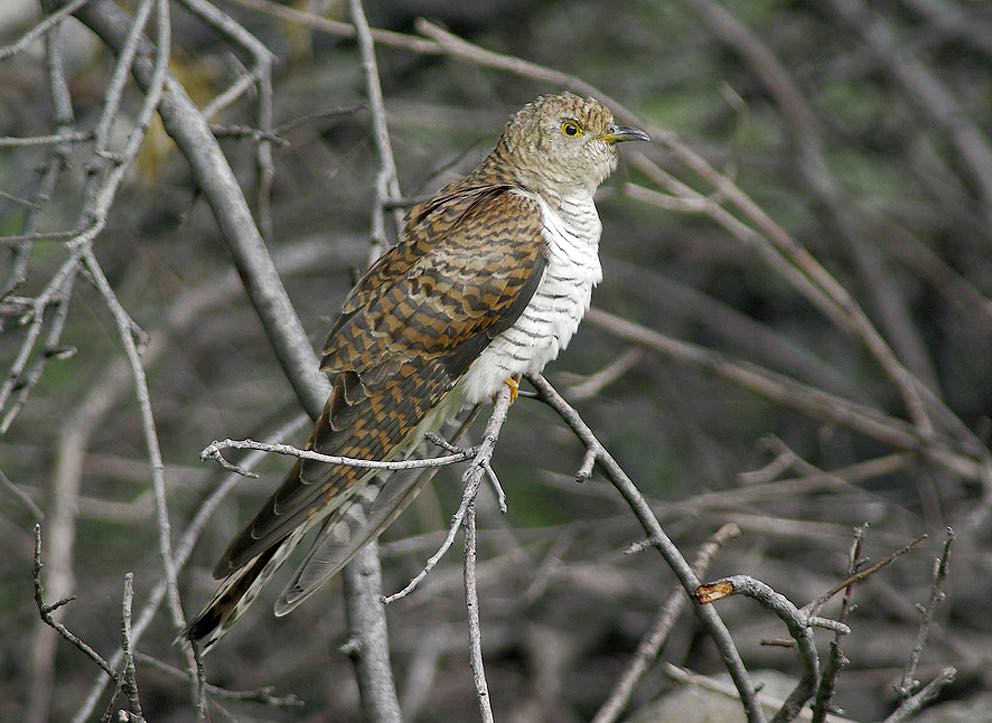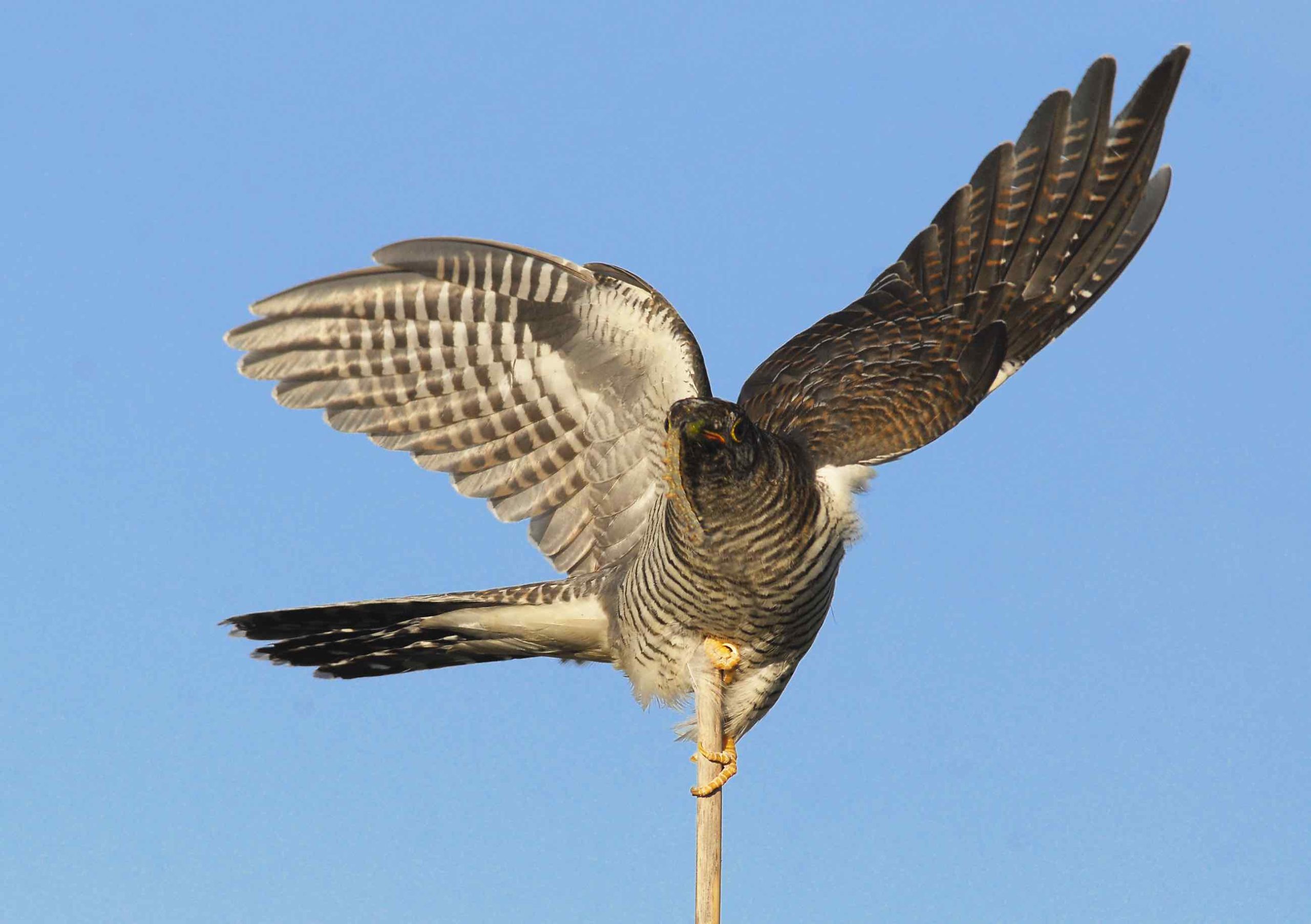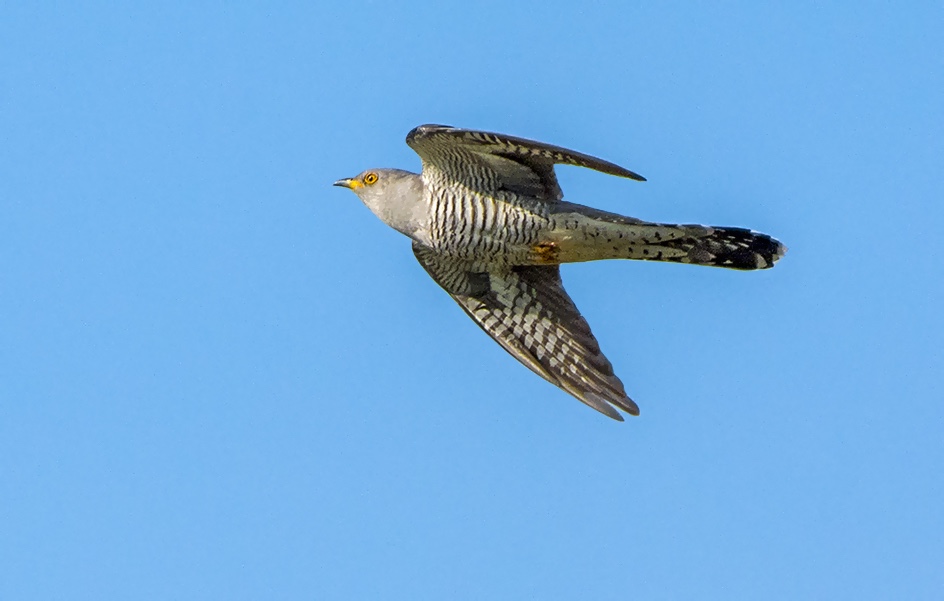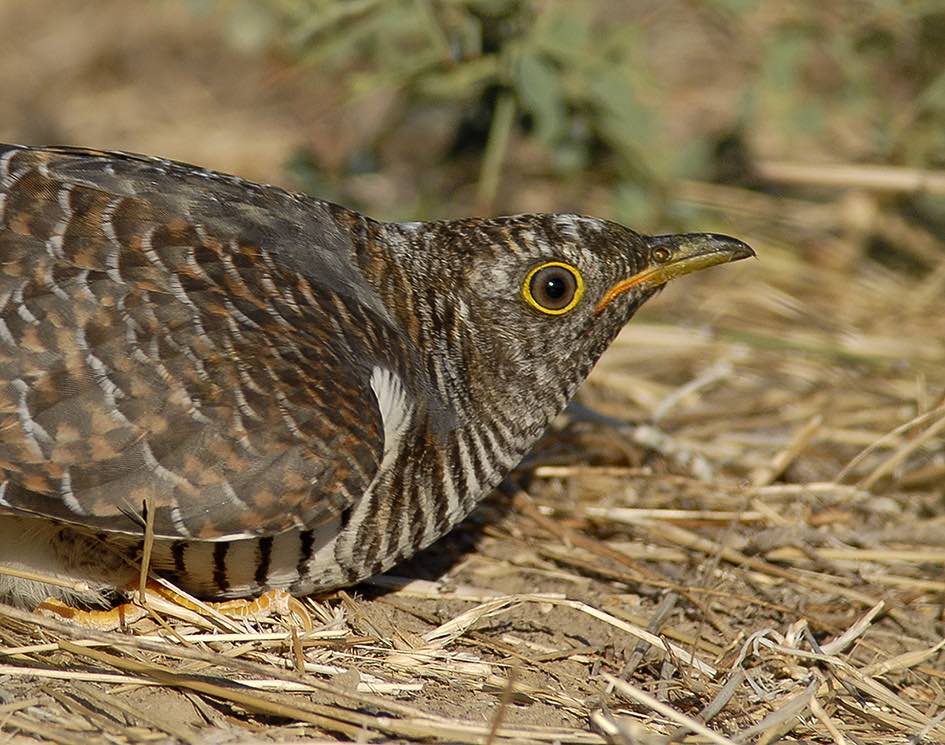2 – Gökotta
on bathing in birdsong

Common Cuckoo Cuculus canorus Sigri, Lesbos, Greece, 21 April 2002 (René Pop).
“Gokotta” is Swedish for the act of waking in the morning with the purpose of going outside and listening to the first birds sing.
If you wanted to indulge in bathing in bird song in the traditional Swedish way you go out between Ascension Day (40 days after Easter) and midsummer’s day, shortly before dawn, and listen in reverie.
When I started this article it was midsummer’s day and Common Cuckoos Cuculus canorus were still calling here in Dorset, England. Now a year later, deep in the coronavirus lockdown, we’re waiting for them to arrive in any numbers all hoping we may hear them from our houses. If we are to bathe it’s going to have to be in our gardens. We humans aren’t the only creatures in an existential battle. The cuckoos’ pesticide crisis continues, as moth and butterfly numbers crash due to pesticide use, and the cuckoos’ beloved caterpillars become scarce.
If you are suffering from nature deprivation and would like a bathe we have made a thirty-minute selection of early morning soundscapes involving cuckoos for you to bathe in. This is the perfect accompaniment to reading Nick Davies’ award winning book Cuckoo: Cheating by Nature (2015). For full details of the recordings, including background species and the habitat where these were recorded, scroll to the bottom.
Common Cuckoo Cuculus canorus 00:00 – 02:59: Emiraşıklar, near Akeski, Turkey, 06:27, 15 May 2015 (Mark Constantine); 03:01 – 03:46: Hortobágyi, Hadjú-Bihar, Hungary, 05:37, 12 May 2019 (Magnus Robb); 03:48 – 04:27: Tres Vrysses, East Macedonia & Thrace, Greece, 2 May 2002 (Magnus Robb); 04:29 – 05:58: Tienhoven, Utrecht, Netherlands, 04:47, 6 June 2006 (Magnus Robb); 06:00– 08:39: Dilijan, Tavush, Armenia, 11:35, 2 May 2011 (Magnus Robb); 08:41 – 10:24: Middlebere, Dorset, England, 04:32, 8 May 2010 (Mark Constantine); 10:26 – 11:39: Äihämäjärvi lake, Norrbotten, Sweden, 02:04, 15 June 2015 (Magnus Robb); 11:41 – 13:12: Hortobágy, Hadjú-Bihar, Hungary, 05:05, 12 May 2019 (Magnus Robb); 13:14 – 13:55: Bialowieza, Podlaskie, Poland, 20:30, 3 May 2005 (Magnus Robb); 13:57 – 15:32: Rust, Burgenland, Austria, 04:46, 12 May 2012 (Mark Constantine); 15:34 – 18:02: Vale da Ribeira das Mercês, São Bras de Alportel, Portugal, 20:07, 26 April 2011 (Magnus Robb); 18:04 – 21:28: Monte de Pancas, Benavente, Portugal, 05:52, 1 May 2012 (Magnus Robb); 21:30 – 22:52: Rosmaninhal, Idanha-a-Nova, Portugal, 05:24, 13 May 2012 (Magnus Robb); 22:54 – 23:48: same location, 06:38, same date (Magnus Robb); 23:50 – 29:23: Jalman meadows, Tuv Almag, Mongolia, 05:43, 26 May 2008 (Magnus Robb); 29:25 – 30:27: same location, 05:48, same date (Magnus Robb).
In his book, Davies explains how a young cuckoo can hiss and make other alarm sounds that it shares with other cuckoos, but when begging in a Eurasian Reed Warbler Acrocephalus scirpaceus nest it makes sounds very similar to the young it has displaced. In fact, J H Zorn first described this as long ago as 1743. Modern experiments show that at one week old the cuckoo calls as often as a typical brood of four reed warbler chicks. By two weeks old it will have speeded up its rate of calling to give the illusion that the reed warbler parents have eight birds in the nest. The parents act accordingly and hurry to bring food more often.
Davies goes on to describe experiments showing that ‘Reed Warbler Cuckoo’ chicks and ‘Dunnock Cuckoo’ chicks (i.e., in Dunnock Prunella modularis nests) are pre-tuned to their hosts’ alarm calls. Eurasian Reed Warbler’s main alarm is a harsh churr; juvenile cuckoos brought up by reed warblers recognise these calls and go silent when they hear them. Dunnock’s alarm is a whistle, and the same happens with cuckoos brought up by Dunnocks.
The book explains that if you take the cuckoo chicks out of their preferred host’s nest and put them in the nest of another species they are unable to recognise (or react to) the other host’s alarm call. This is important. If recognising the alarm calls of a particular host is an innate ability for both male and female cuckoo nestlings, this seems likely to be encoded in the DNA of all members of their particular ‘cuckoo race’, as Davies calls them. In Catching the Bug I had already cited work showing that female cuckoos differ in DNA, depending on the host species they entrust their eggs to, and their daughters will choose the same host, for which they are able to produce a matching egg.

Common Cuckoo Cuculus canorus Chardara, Shardara district, Kazakhstan, 6 September 2009 (René Pop).
Large tracts of more uniform habitat allow larger more stable populations of cuckoos specialising in a particular species, such as ‘Common Redstart Cuckoos’ (using Common Redstart Phoenicurus phoenicurus nests) in the boreal forests of northeastern Europe, and ‘Great Reed Warbler Cuckoos’ (using Great Reed Warbler A arundinaceus nests) in the reedbeds of the Carpathian basin. As Davies explains, the egg mimicry in these ‘cuckoo races’ is very well defined, and we might even talk about each cuckoo being well on the way to becoming a separate species.
Wow, that’s mind blowing. Cuckoos have been known to parasitise over 100 different species, so does that mean there will be 100 new cuckoos? Probably not, but in Europe the most popular hosts are Great Reed Warbler, Eurasian Reed Warbler, Sedge Warbler A schoenobaenus, European Robin Erithacus rubecula, Common Redstart, Dunnock, Pied Wagtail Motacilla yarrellii, White Wagtail M alba, and Meadow Pipit Anthus pratensis. So it might be wise to start looking at the cuckoos specialising in those.
Some birds are thought to have developed techniques to counter cuckoo attacks, having been picked on in the past. Grim et al (2011) tried putting cuckoo eggs in nests of Common Blackbirds Turdus merula, for example, and on hatching the young cuckoos successfully chucked the still unhatched blackbird eggs out of their nests. However, after that it all went wrong: the adult blackbirds would hardly feed the young cuckoos and they died after a few days. The same study found that Song Thrushes T philomelos will feed a young cuckoo but have a nest shape lined with smooth clay that the young cuckoo finds slippery, failing to gain enough leverage to eject the host’s eggs. Interesting as this is this, could it be that there is not a real anti-cuckoo strategy at play in these thrushes but that their adaptations in rearing their own young coincidentally just happen to have a negative effect on the chances of nestling cuckoos? Blackbirds expect their young to behave in a certain way: leaving the nest several days before they can fly and keeping hidden in ground cover at first; and the smooth clay used by Song Thrush may help their own young not to leave their nest too early when panicked by some incident.
Gilbert White’s neighbour in Selbourne suggested that he could hear the different male cuckoos singing at different points in the scale. He could discern one in Selbourne wood that was mostly in D while another time he heard two singing together one in D and one in D sharp… then another time in Wolmer forest a bird sang in C (White 1789). Arnoud pointed out that individual differences in birds with bordering territories are rather the rule than exception since they need to be able to tell who’s who.

Common Cuckoo Cuculus canorus Texel, Noord-Holland, Netherlands, 6 September 2019 (René Pop).
In Catching the Bug we illustrated a Hungarian paper suggesting that male cuckoos in woodland sing at a lower pitch from those in marshes (Fuisz & de Kort 2007). Curiously, this is the opposite of what you might expect if ‘caused’ by differences in habitat. Reedland birds typically have lower-pitched sounds than their relatives that live in woodland. One could think of Eurasian Reed Warbler versus Wood Warbler Phylloscopus sibilatrix songs for example.
When we wake in the morning with the purpose of going outside and listening to the first birds that call, cuckoos are often among them. Although he didn’t know it at the time, Magnus was doing Gökotta when he recorded a cuckoo in Common Redstart habitat in the far north of Sweden, just after Ascension Day in 2015. Compare it with a presumed ‘Reed Warbler Cuckoo’ he recorded four years later in Hungary. The difference in pitch is quite striking. However, individual cuckoos vary in pitch and we are still a long way from being able to diagnose the host species of a cuckoo just from its song.
Presumed ‘Common Redstart cuckoo’ Cuculus canorus Äihämäjärvi lake, Norrbotten, Sweden, 02:04, 15 June 2015 (Magnus Robb). Song of male with bubbling call of female.Background: Willow Warbler Phylloscopus trochilus, Common Redstart Phoenicurus phoenicurus & Brambling Fringilla montifringilla. 150615.MR.020402.21S
Presumed ‘Reed Warbler cuckoo’ Cuculus canorus Hortobágyi, Hadjú-Bihar, Hungary, 05:37, 12 May 2019 (Magnus Robb). Song of a male. Background: Greylag Goose Anser anser, Sedge Warbler Acrocephalus schoenobaenus, Eurasian Reed Warbler Acrocephalus scirpaceus & Common Nightingale Luscinia megarhynchos. 190512.MR.053702.01S
In his book, Nick Davies wonders whether woodland cuckoos sing lower to project further. My experience of cuckoos in marshes is that they sit on a prominent and isolated trees or a post to sing, above the level of the reeds. Assuming they are attracting a mate, their calls will travel for miles. Woodland cuckoos seem to prefer clearings and edges, but there are likely to have significant obstacles at least one side. The deeper sound has a slightly longer wavelength, allowing it to barge past more obstacles than a higher-pitched sound, which would be reflected off branches and clumps of foliage up to a particular size.
One morning on Mallorca last spring, Mo and I discussed a strange Green Woodpecker Picus viridis-like yaffle over breakfast. She had been hearing it outside our villa, and the previous evening I and my sister Sarie, a South African birder experiencing her first Mallorcan spring, had heard it while sitting outside at the end of the day. There are no green woodpeckers of any description on the island so I had lazily suggested: “Wryneck calling”. Mo and I remembered that a week or two earlier Magnus had been visiting us there, and told us that during a night capturing sounds from the same villa the previous year he had recorded a Great Spotted Cuckoo Clamator glandarius migrating, a rare bird on Mallorca. Damn! What does a Great Spotted Cuckoo sound like?
We started to search the garden and surrounding fields. Nothing. “I think it came from the front of the villa,” said Mo. We searched the front, and were delighted and reassured when we found a female Common Cuckoo feeding and calling in the olives. Ah yes that’s it. I was slightly embarrassed but somehow a female calling without the give away clue of the male put it out of context. I don’t know about you but I don’t get to see many female cuckoos. They hide in the bushes while the males are busy being males and dashing about cuckooing. Anyway we all had lovely looks at this female.

Common Cuckoo Cuculus canorus Chardara, Shardara district, Kazakhstan, 6 September 2009 (René Pop).
Relaxing, we listened to Magnus’s recordings of Great Spotted Cuckoo for reference, nothing like female Common Cuckoo or Eurasian Wryneck Jynx torquilla, come to that.
Great Spotted Cuckoo Clamator glandarius, Rosmaninhal, Idanha-a-Nova, Portugal, 04:36, 4 June 2013 (Magnus Robb). Single ‘wails & chuckle’ series in nocturnal flight. Background: Red-necked Nightjar Caprimulgus ruficollis and Eurasian Scops Owl Otus scops. 130604.MR.043616.02
Common Cuckoo Cuculus canorus Napi Valley, Lesvos, Greece, 17 April 2008 (Mark Constantine). Bubbling call of a female. Background: Common Blackbird Turdus merula and Eastern Black-eared Wheatear Oenanthe melanoleuca 08.009.MC.00045.01S
Eurasian Wryneck Jynx torquilla Andratx, Mallorca, Spain, 7 April 2003 (Magnus Robb). Song. Background: Common Wood Pigeon Columba palumbus, Common Firecrest Regulus ignicapilla, Great Tit Parus major, Eurasian Wren Troglodytes troglodytes and Common Chaffinch Fringilla coelebs. 03.009.MR.04636.11
A week later at the same spot a male cuckoo was calling very strangely. We found it and noticed retained juvenile feathers in the back… a young male obviously still on its way to its breeding grounds. It’s interesting to speculate why its calls were not quite right. Was it still developing the right muscles to deliver its innate cuckoo calls correctly? Or would competition with fully adult cuckoos on the breeding grounds help to crystallise its calls, suggesting that there is an element of learning? Cuckoos are non-oscines and therefore not supposed to be able to learn sounds, but more on that in the next article.
Are there several species of ‘Common Cuckoos’ or not? Studies in Japan and Britain have shown that male cuckoos often mate with females of more than once ‘race’ (Marchetti et al 1998, Southern 1954), which seems likely to prevent speciation taking place. Interestingly, however, Davies points out that both studies were in areas of fragmented habitat, strongly modified by humans. Meanwhile, an experiment in Bulgaria (Fossøy et al 2011) showed that even in fragmented habitat the birds that parasitised Marsh Warbler A palustris, Great Reed Warbler and Corn Buntings Emberiza calandra all had small but significant differences in DNA.
Cuckoos show us the impossible task we have when we apply the man-made term, ‘species’, to the rich variation offered when “cheating by nature”.
Davies, N 2015. Cuckoo: Cheating by Nature. London.
Fossøy, F, Antonov, A, Moksnes, A, Røskaft, E, Vikan, J R, Møller, A P, Shykoff, J A & Stikke, B G 2011. Genetic differentiation among sympatric cuckoo host races: males matter. Proceedings of The Royal Society B 278: 1639-1645.
Fuisz, T I & de Kort, S R 2007. Habitat-dependent call divergence in the common cuckoo: is it a potential signal for assortative mating? Proceedings of the Royal Society B 274: 2093-2097.
Grim, T, Samaš, P, Moskát, C, Kleven, O, Honza, M, Moksnes, A, Røskaft, E& Stokke BG 2011. Constraints on host choice: why do parasitic birds rarely exploit some common potential hosts? Journal of Animal Ecology 80: 508-518.
Marchetti, K, Nakamura, H & Gibbs, H L 1998. Host-race formation in the Common Cuckoo. Science 5388: 471-472.
Southern, H N 1954. In: Evolution as a process, pp 219-232. . Huxley, J, Hardy, A C & Ford, E B eds. London.
White, G 1789. The natural history and antiquities of Selbourne. London.
Zorn, J H 1743. Petino-Theologie oder Versuch, die Menschen durch nähere Betrachtung der Vögel zur Bewunderung Liebe und Verehrung ihres mächtigsten, weissest- und gütigsten Schöpffers aufzumuntern. Pappenheim.
30 minutes of Common Cuckoo song – full captions
(00:00 – 02:59) Common Cuckoo Cuculus canorus Emiraşıklar, near Akseki, Turkey, 06:27, 15 May 2015 (Mark Constantine). Song of a male in patchy habitat of oak scrub and small pine copses. Background: European Turtle Dove Streptopelia turtur, Barn Swallow Hirundo rustica, Eurasian Coal Tit Periparus ater, Eastern Bonelli’s Warbler Phylloscopus orientalis, Common Blackbird Turdus merula and Common Chaffinch Fringilla coelebs. 140515.MC.062700.02S
(03:01 – 03:46) Common Cuckoo Cuculus canorus Hortobágy, Hajdú-Bihar, Hungary, 05:37, 12 May 2019 (Magnus Robb). Song of a male in marshland. Background: Greylag Goose Anser anser, Sedge Warbler Acrocephalus schoenobaenus, Eurasian Reed Warbler Acrocephalus scirpaceus and Common Nightingale Luscinia megarhynchos. 190512.MR.053702.01S
(03:48 – 04:27) Common Cuckoo Cuculus canorus Treis Vrisses, East Macedonia & Thrace, Greece, 2 May 2002 (Magnus Robb). Song of a male in open oak woodland. Background: Eastern Bonelli’s Warbler Phylloscopus orientalis, Common Chaffinch Fringilla coelebs and Ortolan Bunting Emberiza hortulana. 02.021.MR.12508.21T
(04:29 – 05:58) Common Cuckoo Cuculus canorus Tienhoven, Utrecht, Netherlands, 04:47, 6 June 2006 (Magnus Robb). Song of a male in marshland. Background: Marsh Frog Pelophenax ridibundus, Sedge Warbler Acrocephalus schoenobaenus, Eurasian Wren Troglodytes troglodytes and Song Thrush Turdus philomelos, 060605.MR.44705.10T
(06:00 – 08:39) Common Cuckoo Cuculus canorus Dilijan, Tavush, Armenia, 11:35, 2 May 2011 (Magnus Robb). Song of a male in mature deciduous woodland; note the wave of unrest when he flies a short distance at 08:08 -08:20. Background: Common Wood Pigeon Columba palumbus, European Green Woodpecker Picus viridis, Eurasian Blue Tit Cyanistes caeruleus, Eurasian Nuthatch Sitta europaea, Common Chaffinch Fringilla coelebs and European Goldfinch Carduelis carduelis. 110502.MR.113516.01S
(08:41 – 10:24) Common Cuckoo Cuculus canorus Middlebere, Dorset, England, 04:32, 8 May 2010 (Mark Constantine). Song of a male in marshland. Background: Common Pheasant Phasianus colchicus, Common Wood Pigeon Columba palumbus, Eurasian Blue Tit Cyanistes caeruleus, Common Whitethroat Sylvia communis, Eurasian Reed Warbler Acrocephalus scirpaceus and European Robin Erithacus rubecula. 100508.MC.043200.02S
(10:26 – 11:39) Common Cuckoo Cuculus canorus Äihämäjärvi lake, Norrbotten, Sweden, 02:04, 15 June 2015 (Magnus Robb). Presumed ‘Common Redstart cuckoo’ in swampy spruce forest:song of a male with bubbling calls of female; also gruff ‘gobbling’ sounds of male and excited three-note songs. Background: Willow Warbler Phylloscopus trochilus, Common Redstart Phoenicurus phoenicurus and Brambling Fringilla montifringilla. 150615.MR.020402.21S
(11:41 – 13:12) Common Cuckoo Cuculus canorus Hortobágyi, Hadjú-Bihar, Hungary, 05:05, 12 May 2019 (Magnus Robb). Song and excited chatter of a male in marshland. Background: Greylag Goose Anser anser, Common Moorhen Gallinula chloropus, Eurasian Blackcap Sylvia atricapilla, Savi’s Warbler Locustella luscinioides, Eurasian Reed Warbler Acrocephalus scirpaceus, Sedge Warbler A schoenobaenus, Moustached Warbler A melanopogon and Common Reed Bunting Emberiza schoeniclus. 190512.MR.050510.00S
(13:14 – 13:55) Eurasian Woodcock Scolopax rusticola and Common Cuckoo Cuculus canorus Bialowieza, Podlaskie, Poland, 20:30, 3 May 2005 (Magnus Robb). Roding of a male woodcock and song of a male cuckoo at dusk in varied mixed woodland. Background: Common Blackbird Turdus merula and Song Thrush T philomelos. 05.006.MR.04331.01S
(13:57 – 15:32) Common Cuckoo Cuculus canorus Rust, Burgenland, Austria, 04:46, 12 May 2012 (Mark Constantine). Song of a male in marshland. Background: Gadwall Mareca strepera, Indian Peafowl Pavo cristatus, Feral Pigeon Columba livia, Eurasian Bittern Botaurus stellaris, Common Kestrel Falco tinnunculus, Hooded Crow Corvus cornix, House Martin Delichon urbicum, Eurasian Blackcap Sylvia atricapilla, Sedge Warbler Acrocephalus schoenobaenus, Great Reed Warbler A arundinaceus and House Sparrow Passer domesticus. 120512.MC.044600.21S
(15:34 – 18:02) Common Cuckoo Cuculus canorus bangsi Vale da Ribeira das Mercês, São Bras de Alportel, Portugal, 20:07, 26 April 2011 (Magnus Robb). Song of an Iberian male in open woodland or ‘montado’. Background: Common Blackbird Turdus merula, Common Nightingale Luscinia megarhynchos and Corn Bunting Emberiza calandra. 110426.MR.200732.21S
(18:04 – 21:28) Common Cuckoo Cuculus canorus bangsi Monte de Pancas, Benavente, Portugal, 05:52, 1 May 2012 (Magnus Robb). Nocturnal song of an Iberian male in open woodland or ‘montado’. Background: European Nightjar Caprimulgus europaeus, Tawny Owl Strix aluco, Carrion Crow Corvus corone, Eurasian Wren Troglodytes troglodytes, Common Blackbird Turdus merula and Common Nightingale Luscinia megarhynchos. 120501.MR.055236.21S
(21:30 – 22:52) Common Cuckoo Cuculus canorus bangsi Rosmaninhal, Idanha-a-Nova, Portugal, 05:24, 13 May 2012 (Magnus Robb). Song of a high-pitched Iberian male in open woodland or ‘montado’. Background: Common Wood Pigeon Columba palumbus, Red-necked Nightjar Caprimulgus ruficollis, European Scops Owl Otus scops and Thekla’s Lark Galerida cristata. 120513.MR.052446.01S
(22:54 – 23:48) Common Cuckoo Cuculus canorus bangsi Rosmaninhal, Idanha-a-Nova, Portugal, 06:36, 13 May 2012 (Magnus Robb). Song of the same male just over an hour later, after daybreak. Background: Common Wood Pigeon Columba palumbus, Eurasian Hoopoe Upupa epops, Thekla’s Lark Galerida theklae, Spotless Starling Sturnus unicolor, Common Chaffinch Fringilla coelebs and Corn Bunting Emberiza calandra. 120513.MR.063638.00S
(23:50 – 29:23) Common Cuckoo Cuculus canorus Jalman meadows, Tuv Almag, Mongolia, 05:43, 26 May 2008 (Magnus Robb). Song of a male, with Mongolian taiga dawn chorus. Background: Oriental Cuckoo Cuculus optatus, Little Ringed Plover Charadrius dubius, Common Sandpiper Actitis hypoleucos, Eurasian Hoopoe Upupa epops, Daurian Jackdaw Corvus dauuricus, Azure Tit Cyanistes cyanus, Willow Tit Poecile montanus, Siberian Lesser Whitehroat Sylvia althaea blythi, Red-throated Thrush Turdus ruficollis, Taiga Flycatcher Ficedula albicilla, Olive-backed Pipit Anthus hodgsoni and Black-faced Bunting Emberiza spodocephala. 080526.MR.054334.01S
(29:25 – 30:27) Oriental Cuckoo Cuculus optatus and Common Cuckoo C canorus Jalman meadows, Tuv Almag, Mongolia, 05:48, 26 May 2008 (Magnus Robb). Song of an Oriental Cuckoo, later joined by the same male Common Cuckoo that was in the preceding recording. Background: Common Snipe Gallinago gallinago, Daurian Jackdaw Corvus dauuricus, Eurasian Hoopoe Upupa epops, Azure Tit Cyanistes cyanus, Siberian Lesser Whitehroat Sylvia althaea blythi, Taiga Flycatcher Ficedula albicilla and Olive-backed Pipit Anthus hodgsoni. 080526.MR.054834.00S